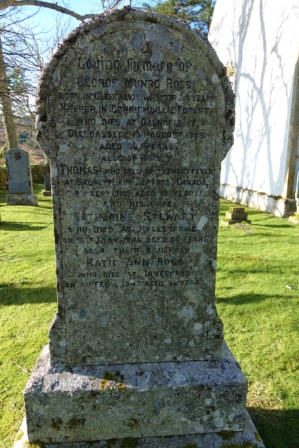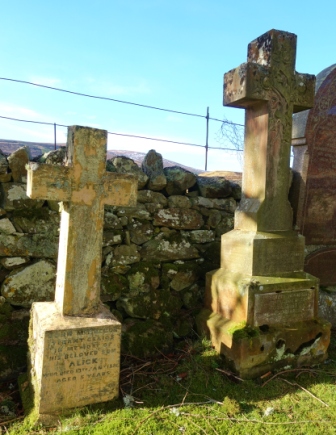
When Sir John Lockhart Ross of Balnagowan joined the frenzy for making money from introducing sheep and deer to Highland estates he gave no thought to evicting people who lived and worked his vast acres from their homes in the straths and glens their families had occupied for generations. The land was his and he would do what he liked with it and he had a lackey eager to do his bidding.

On the afternoon of 24th May 1845 among the several hundred evicted from their homes that day from in Glen Calvie in Sutherland, that is ordered out of their homes, unroofed behind them and herded away like so many cattle, 90 sought refuge in Croick graveyard. These were law abiding, God-fearing people who resisted the attacks on them and their way of life but were beaten by the ruthlessness of those with wealth and power and their toadies.

A few of the evicted did find alternative areas to farm and live but the numbers were so great that many did not. The 90 who crowded into the graveyard did not attempt to go into the church out of fear of causing offence. What does that tell you?

A few scratched messages on the church’s windows during this clearance, and a later one from Greenyards in Strathcarron in 1854, known as the Massacre of the Rosses, and their words remind us the Clearances were tragic and despicable and happened to real people like you and me.

Croick Church is at the end of a long single-track road up lovely Strathcarron. It was one of 43 churches funded by the British government at the end of the Napoleonic Wars, as a thank you for the contribution of strathfolk to the French Wars – the contribution being a rich supply of men and boys prepared to fight and die for a cause a long, long way from their homes and cares.

Strathcarron’s menfolk in common with every other glen and strath in Scotland were much sought after by the British state, and their clan chiefs before then, for their bravery in battle; plentiful supplies of young and strong men who fitted the role of cannon fodder perfectly.

So these churches, built with money made available by the government were called Parliamentary churches for that reason and were provided with an annual minister stipend of £120. Croick was built in 1827 and Thomas Telford was involved in selecting the designs of these Parliamentary churches and their manses but I don’t believe he designed them.

While young strapping men might have been appreciated as a fighting resource (perhaps not quite the right term) by the authorities as long as they wore the uniform of the state, and fought for its interests and not against, they were designated insignificant when not required for military service. And neither they nor their families were respected when it came to evicting them at short notice when the land was wanted as hunting muirs – then those communities were disposed of as any other property only with less value to the lairds and their lackeys than grazing beasts.

The Clearances were shocking and a disgrace although there are some today who would excuse them or try to diminish their significance in the history of this country as part of their rightwing political narrative. But there are always reactionaries blind to truth.
The shameful events of the clearing of Glen Calvie was reported at the time in the Times of London in a piece which recognised the reprehensible nature of the action – turning people out by force and making them into beggars.

“Behind the church, a long kind of booth was erected, the roof formed of tarpaulin stretched over poles… horsecloths, rugs, blankets and plaids … their bedding and their children they all removed on Saturday afternoon to this place… they had been round to every heritor and factor in the neighbourhood, and 12 of the 18 families had been unable to find places of shelter…”.

The man who physically carried out this act was the estate’s factor James Gillanders of Tain. His first attempts at serving eviction notices on the people were actively rebuffed by the womenfolk of the glen who burned the papers. This was in 1843.

Gillanders succeeded the following year, avoiding the women he tricked the men into receiving the summonses. Observant of the law the people did not resort to violence in the face of such an outrage. They lost homes, means of living and feeding their families, communities and their entitlement (as it was) to land that stretched back generations and centuries.

Among the 90 people who grouped together like animals outside the church that May were 23 children under ten years of age, including tiny babies, 10 over the age of 60 years and several in poor health.

Some of the scratched messages showing that even from the most isolated glens the people were literate.
Among the scratched comments are:
GLENCALVIE IS A WILDERS …. BELOW SHEEP THAT …. TO THE …. CROICK
GLENCAL PEOPL WAS IN THE CHURCHYARD HERE MAY 24 1845
THE GLEN…. PEOPLES WERE HERE 1845 THE GLENCALVIE ROSS
JOHN ROSS 1854 …. GLEN….. 24
THE GLENCALVIE TENANTS RESIDED HERE MAY 24 1845
GLENCALVIE …. MAY
GLENCALVIE PEOPLE THE WICKED GENERATION GLENCALVIE
GLENCALVIE TENANTS RESIDING HERE
GLENCALVIE GREENYARD MURDER WAS IN THE YEAR 1854 MARCH 31
THE GLEN…. PEOPLES WERE HERE 1845 THE GLENCALVIE ROSS
JOHN ROSS SHEPHERD CROICK THE GLENCALVIE …. HERE MAY 24TH 184
THIS HOUSE IS NEDING REPAIR

.
The instrument of this evil, or rather the one who physically carried out the act for it was greater than this appalling man, Gillanders, was buried in Croick graveyard and it should come as no surprise his grave was frequently strewn with rubbish as an indication of how he was regarded by locals.

Glen Calvie is now a sporting estate, wouldn’t you know it? In presumably unwitting irony the holders of the estate explain how the strath has “been continuously inhabited since the end of the last ice age.” With what is not explained. Neither does the estate website care to linger on the story of the Clearances from the glen but it does provide a link to http://croickchurch.com and it does acknowledge “This history is only partial and incomplete.” Aye to that.
